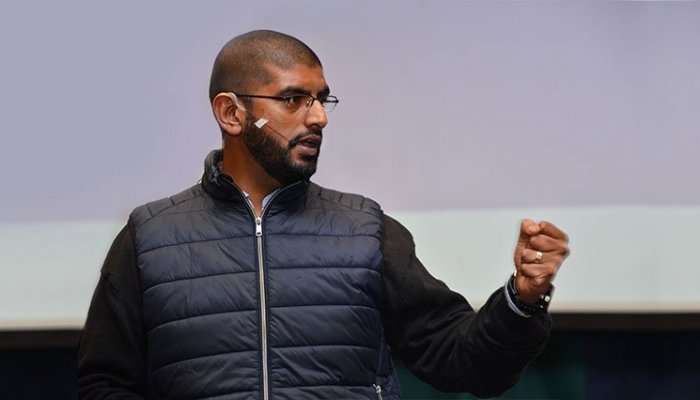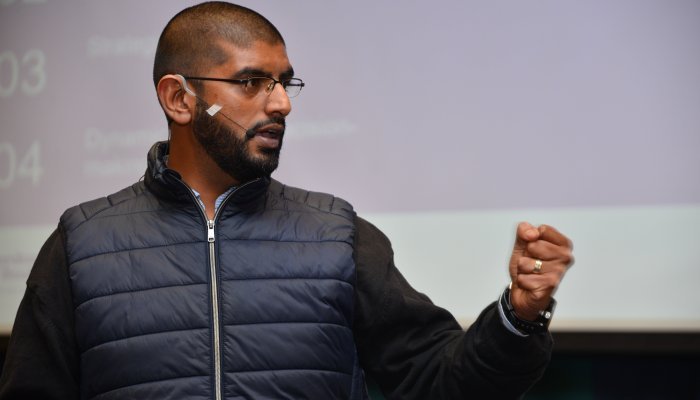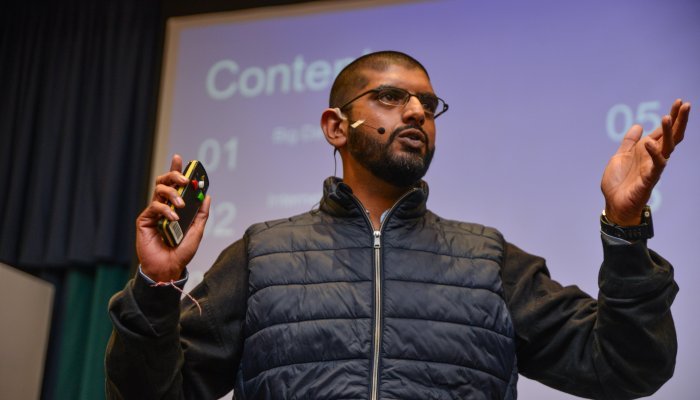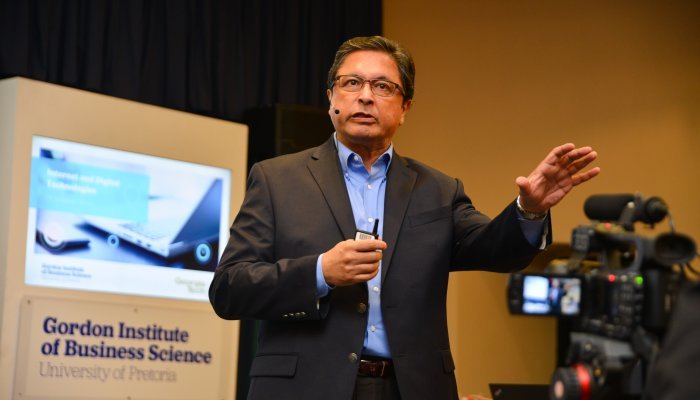Disruption, whether as a result of disruptive technologies (which displace well-established technologies) or digital disruption (where the value proposition of businesses is being changed through the adoption of digital technology), is having a profound impact on operational models and consumer engagement.
Obvious examples of the disruption taking place globally are the proliferation of e-commerce platforms, including giants such as Amazon, Alibaba and eBay, the demise of print media due to the consumption of online news through applications and social media and mobile money offerings. The latter, exemplified by the likes of M-Pesa, are filling the gap left by legacy banks, while credit cards are making way for e-payment offerings such as PayPal, Google Wallet and Masterpass. In China, Dr. Soumen Ghosh, Professor of Operations and Supply Chain Management in the Scheller College of Business at Georgia Tech, told delegates, digital money is so ubiquitous that even beggars have resorted to wearing QR codes to make it easier for people to give them money.
A golden thread running through the conference was the need to keep pace with change. Indeed, given the exponential speed at which technologies are evolving, business needs to heed the words of naturalist Charles Darwin in The Origin of the Species: “It is not the most intellectual of the species that survives; it is not the strongest that survives; but the species that survives is the one that is able to adapt to and to adjust best to the changing environment in which it finds itself.”
...the consumer now holds the power.
In the future, if businesses cannot adapt to fit into the new paradigm, they will ultimately be doomed to failure.
It’s all about the consumer
The first major shift taking place in the future world is that, for the first time in history, the customer is more important than the producer. Management consultant and GIBS lecturer Manoj Chiba told delegates that the focus of business is now changing from one where businesses pushed products into and onto markets, to one where the consumer is driving the process. Consumers are expecting companies to understand their needs better and, with access to real time and big data, it is about businesses harnessing this technology to better service their consumer base. Chiba noted: “For the first time business has to consider the customers and offer a customised user experience. Customers are realising that businesses now need ‘my input’. This is a fundamental shift and the consumer now holds the power.”
Ghosh agreed with Chiba and explained that in the value chain – made up of raw materials, suppliers, manufacturers, distribution, customers/retail outlets and, finally, consumers – the major disruption will take place right at the end of the value chain. And the people driving change are Generation Z (born mid-1990s to mid-2000s) as they are the ones most readily adopting technology and using it to their advantage.
Some areas of the value chain face an uneasy future, as middlemen come under pressure due to disintermediation. Ghosh believes it won’t be long before manufacturers go directly to their customers and consumers. One scenario raised during the conference was the example of a shoe manufacturer sending their shoe blueprint to the consumer, who will then be able to use that design to print their own flip-flops at home on a 3D printer. They will be able to customise the colour and design of the shoe, making it uniquely theirs and cutting out a range of services in between, from logistics to retail stores.
Choice vs. cost
Another interesting trend is that of product- or SKU-proliferation, meaning that consumers are demanding greater variety and choice in the products they buy. While in the past, businesses have sought to increase their efficiencies by reducing product ranges and streamlining operations, manufacturers are now required to produce fewer units, but in more product lines. This is resulting in an increase in production costs.
Make it personal
Alongside this need for choice, is the increased desire for greater personalisation. Whether it is a product or a service, people are looking for personalised options. In our modern world, each individual wants to feel important, and they are willing to pay a premium for customisation to reinforce this view.
To cater to this increasing need, organisations are starting to look at ways in which they can customise products for individual consumers. The extent to which companies are willing to meet this need is highlighted by some of the examples being explored by companies currently. Coca-Cola, for example, is looking at mix-and-match six packs which may include regular and sugar-free Coke options. Or, if someone is throwing a birthday party, the beverage company may be willing to print their name on all the cans.
Global pasta brand, Bertolli, is trialling a custom-made pasta option. Customers can send the company a picture or a shape showing how they want their pasta to look and the company will 3D print a custom batch. While, in Japan, food giant Nestlé is piloting a scheme called the Nestlé Wellness Programme which allows people to send Nestlé their DNA, pictures of what an average meal looks like, and a breakdown of their lifestyle, and the company will make them a customised vitamin and mineral supplement.
Convenient consumption
Consumers are also eager for companies to take the bother out of their day-to-day activities. Ghosh called this ‘frictionless commerce’. It makes use of technologies such as biometrics, facial recognition or voice-based ordering to recognise consumers. We are already seeing the infancy of this type of technology being used at airports to log tourists as they come in and out of a country. Amazon, however, is piloting this technology in their staff-free Amazon Go stores where customers can walk into a store, pick out what they need and walk out. Who they are and what they have purchased is determined by scanners, and the customer is billed directly to their mobile device or bank account as they exit the store. In China, Alibaba has a similar concept in Tao Cafe which enables consumers to walk into the café and be recognised through facial recognition. They can then decide to eat in or have a takeaway, and their orders will be charged directly to them through a mobile payment system. Like Amazon Go, Tao Cafe is completely staff-free.
...it won’t be long before manufacturers go directly to their customers and consumers.
Although this type of technology raises issues around the consumer’s right to privacy, it is predicted that voice-recognition shopping through devices like Amazon Alexa or Apple’s Siri will reach US$40 billion by 2022 – showing that people may prefer convenience over privacy.
Bring it to me
One key trend driving consumer behaviour is the desire of consumers to have their goods delivered to their doorstep. In 2018, 1.8 billion people around the world purchased goods online. According to statistics website Statista, the value of these transactions amounted to US$2.8 trillion, and it is predicted this amount will nearly double to US$4.8 trillion by 2021. Young people, in particular, are driving the e-commerce disruption.
Now, food services are also getting in on the action. Gone are the days of fast food equalling junk food. Consumers are now demanding a restaurant experience in their homes and want restaurant-quality food delivered to their doorstep, said Ghosh.
The need for speed
But getting goods delivered is not good enough, consumers no longer want to wait for their products to arrive. To cater to this need Amazon has invested US$800 million into improving their delivery times. Ghosh explained that Amazon has managed to bring its delivery times to under 24 hours across 97% of the United States. The impact this will have on the speed at which goods need to be produced and supplied is going to be significant; opening up another area of focus and concern for businesses.
As Ghosh said: “Consumer demand trends are becoming increasingly volatile. So forecasting and predicting demand is going to be a nightmare for manufacturers and suppliers of goods.”
Robotics, however, may hold the key to helping businesses keep up. Dr. Peter Corke, Professor of Robotics at Queensland University of Technology, highlighted the importance of robotics across the value chain. Not only are retailers like Amazon driving the use of robots in their organisations, with Amazon employing more than 200 000 robots in their warehouses to move products around and bring them to the packers, robots are also helping to streamline costs and reduce the environmental footprints of sectors like mining, farming, forestry, construction, logistics, undersea exploration and medical services. A major consideration for the modern consumer.
The environmental consumer
Business can, and must, pay attention to matters environmental as well as social, heard delegates. Today’s consumers are extremely aware of the impact business is having on the planet, societies and their health. Businesses must, therefore, be diligent around issues of traceability, as consumers are increasingly demanding to know the background of their products and are actively pursuing better-sourced products. And, in an age of social media, the reputational risks associated with misinforming the public can be devastating.
Environmental consciousness is also driving advances in the physical technology we use. Dr. F. Kennedy McDaniel, chief of staff for biotech firm Koniku, explained that tech manufacturers need to be cognisant of e-waste, which is a major environmental problem globally. She called on businesses to focus on the circular economy and look to recycle and repurpose tech. One way to do this is to adopt radical new technologies using biological components, in other words using living organisms to power and drive our technology.
The reality of disruption
Ultimately the disruption facing business is being driven by technological advances which the consumer is adopting with alacrity. For businesses to stay one step ahead in this ever-evolving space, they must collaborate. The speed at which digital and technological advances are changing the way the value chain operates means that producers of primary and raw materials have to work hand-in-hand with manufacturers, who in turn must collaborate with their customers to meet their demands. No longer can different segments of the value chain work in silos.
Ghosh offered a stern warning to businesses saying that organisations that are slow to adapt to, and adopt, this technology are ultimately bound to fail. So, future-focused businesses have to engage with these changes and ask: “How do we catch up?”
KEY TAKEAWAYS
· Digital disruption and disruptive technologies are affecting operational models and consumer engagement.
· Businesses that fail to adapt to the new paradigm are ultimately be doomed to failure.
· The rise in influence of the consumer is a key trend, impacting value chains, middlemen and business models.
· Personalisation, convenience, choice and ethical considerations are areas of interest for future-focused organisations.
· Collaboration within and between sectors may well hold the key for businesses battling to adapt.













